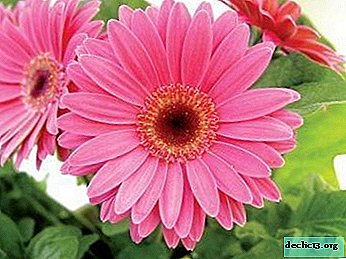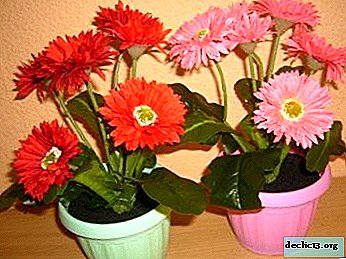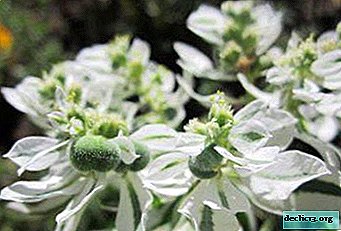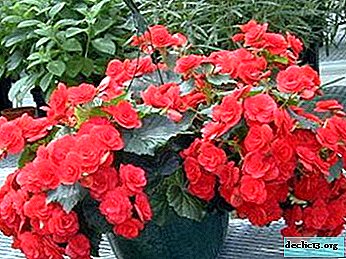“Flower of happiness and success” indoor gerbera: home care, cultivation features

Florists, who have all the conditions for the maintenance of flowering plants, are engaged in the propagation of gerberas on window sills. They need to be looked after in almost the same way as other plants.
And, if everything is done correctly, the flowers will delight with their beauty and decorate the house for many years. In this article you will tell in detail how to care for this delicate flower at home. It will also be useful to watch a video on this topic.
What it is?
Gerbera is a perennial flowering plant that belongs to the Astrov family. Flowers can grow both in open ground and in greenhouses. Their stem reaches 50 cm in height. In nature, there are low and miniature species that do not grow more than 30 cm. Gerberas have spread throughout the planet. There are more than 10 varieties of such a plant. In wildlife, they can be found in Africa and Madagascar. The historical homeland of gerbera is South Africa. This elegant flower resembles a simple daisy in appearance.
The necessary conditions
 Gerbera is a plant that needs a long daylight. If it blooms in winter or autumn, then the light should come in for 12 hours. At the end of March, a gerbera can be located on the window - there will be more than enough natural lighting for it.
Gerbera is a plant that needs a long daylight. If it blooms in winter or autumn, then the light should come in for 12 hours. At the end of March, a gerbera can be located on the window - there will be more than enough natural lighting for it.- The best solution would be to choose windows that look east or west, as the leaves may begin to fade from the strong midday sun.
- In June, when the frosts pass, the plant can be planted in the garden or put it on the balcony.
- During the summer, the gerbera will delight in exuberant flowering. The optimal growing temperature is 18-20 degrees during the growth period.
- When flowering, it is important to prevent sudden changes in temperature. When the air temperature is lowered to 12 degrees, the plant will go into a dormant state.
- In summer it is better to put it on a balcony or a loggia - a gerbera is not afraid of wind and drafts, but it needs protection from direct sunlight. Such actions will help to prepare for repeated flowering, which will last from October to March. Additional lighting must be provided at this time.
- From early spring to the end of summer, a gerbera needs high humidity. To create it, the pot is placed on a pallet filled with expanded clay and pebbles, and then air is sprayed around the plant. It is not necessary to spray on the leaves - it is necessary to avoid getting water into the outlet and subsequent decay.
Gerbera transplant in a new pot
ATTENTION: When a flower is planted in new soil, it is carefully inspected - dry roots are removed, good ones are pruned. Thus, good rooting and development is ensured. Drain, substrate is placed in the tank, and then a bush is placed. The rest of the earth is placed evenly around.It is important to ensure that the root collar is on the surface and not covered by ground. If everything is done correctly, young leaves will appear very soon. Starting a conversation about a transplant, it is worth noting that there are many disagreements on this issue. Every 2 years, the substrate should be changed and the pot disinfected.. The procedure is carried out in the spring, before the gerbera begins to grow actively. It is better to do this in March or April.
The soil for gerberas consists of:
- Two shares of leafy land.
- One share of peat.
- One share of sand.
Do not add humus or compost to the soil. The substrate used for sale is often not suitable for home use. For an adult plant, you need to choose a container whose size is 1.5 liters. A larger pot should not be used. A good solution would be to use a ceramic pot with drainage holes - it will help save the plant from overheating on a hot day.
In summer, the pot needs to be taken out onto the balcony, as fresh air and natural temperature differences will bring a lot of benefits to the plant.
Watch a video about gerbera transplant rules:
How to care after purchase?
 First, the flower is checked for pests.. When they are found, the foliage is treated with Fitoverm or Aktara according to the instructions.
First, the flower is checked for pests.. When they are found, the foliage is treated with Fitoverm or Aktara according to the instructions.- The temperature should be at the level of 20-24 degreesso that the gerbera adapts faster. The state of rest occurs at a temperature of 10-12 degrees, with poor watering.
- Indoor flower loves watering with warm, protected water. It is not allowed to water with a cold liquid, since in this way the gerbera can begin to hurt.
- High humidity is an important condition. To ensure it, the pot is placed in a pan, on the bottom of which water is poured. The bottom of the pot should not touch moisture, and if desired, you can also mulch the soil.
The home plant is so unpretentious in care that a child can cope with it. Just follow a few simple growing rules.
- Gerbera prefers sunlight. It grows best in a well-ventilated area.
- Watering must be plentiful - For this, warm water is used at about 20 degrees. Gerbera does not tolerate watering with cold water even in extreme heat. This can lead to the death of the plant. The best option would be watering in a pan - so you can avoid rotting of the roots. Excess water, at the same time, is better to wash off. In a great way, the plant will feel when sprayed, but you should also avoid getting water on the flowers.
- The temperature during flowering should be 20 degrees. In summer, it is worth taking the flower out into the air, and you need to keep it in winter at a temperature of 14 degrees. This dormant period plays an important role, since in autumn and winter the plant grows leaves and prepares for flowering.
Watch a video on gerbera care after purchase:
Growing problems
Many gardeners are wondering why a home gerbera may not have flowering. The fact is that this flower loves light very much, and when it receives it in insufficient quantities, it immediately stops blooming. It is worth arranging additional lighting - then it will be pleasing to the eye both in summer and in winter.
When the gerbera leaves begin to turn yellow and even crumble, this indicates that a spider mite appeared on the plant. This can happen if the flower is not watered in a timely manner. It is important to spray it every day and check the leaves. The tick can be detected with the naked eye.
IMPORTANT: It should be noted that a separate type of plant - a hybrid gerbera, requires the same careful care.Diseases and Pests
The most common diseases and pests include the following:
 Fusarium. This is a fungal disease that penetrates all tissues. Infected specimens will lag behind in growth, wither and die. The disease spreads with the remains of vegetation, can be transmitted through the soil.
Fusarium. This is a fungal disease that penetrates all tissues. Infected specimens will lag behind in growth, wither and die. The disease spreads with the remains of vegetation, can be transmitted through the soil.- Rot. It gradually affects the organs of the plant. A gray coating forms on diseased tissues, and the only way to deal with the disease is to take the Rovral preparation and treat it with a gerbera once every 10 days.
- Powdery mildew. Plaque on the leaves has a white color - it gradually leads to wrinkling. The fungus can affect inflorescences, peduncles and buds. Plants can lag behind in development, and processing can be carried out 3 times, withstanding an interval of 10 days.
- Verticillus wilting. The main symptom is leaf wilting - they can turn brown, and then dry out. The fungus remains in the ground for a long time.
- Downy mildew. On the leaves of gerberas, oval spots of red color are observed. At the first symptoms, treatments are performed with Acrobat MC, Previkur, Strobi. All this can take up to 7 days.
- Whitefly She settles on the leaves and flowers below. Affected parts turn yellow or brown. Spraying is carried out with such drugs - Aplaud, Mospilan.
- Thrips. These are carriers of viruses. Signs of infection may be pink and yellow spots. Adult individuals settle on flowers, and in order to get rid of them, they use Decis-Extra and Actellic solutions. The number of treatments is 2-3 times, and the interval is from a week to ten days.
- Spider mite. He sucks the juice from the plants. The first signs are the formation of small dots on the leaves, in the lower parts of which ticks begin to settle. The next stage is drying and falling of leaves. Plants are braided by cobwebs. As a treatment, you can use Fitoverm, Vertimek. Reprocessing can be done after 3 weeks.
Conclusion
From this article, you learned about how to care for gerberas, and what features this flower has. If you follow all the recommendations, care will not seem difficult, and the plant will please with its beauty and elegance. For those who want to create a small greenhouse in their home, a gerbera is the best choice. Varieties of flowers and abundant flowering will decorate the windowsill and make it a real pride.

 Gerbera is a plant that needs a long daylight. If it blooms in winter or autumn, then the light should come in for 12 hours. At the end of March, a gerbera can be located on the window - there will be more than enough natural lighting for it.
Gerbera is a plant that needs a long daylight. If it blooms in winter or autumn, then the light should come in for 12 hours. At the end of March, a gerbera can be located on the window - there will be more than enough natural lighting for it. First, the flower is checked for pests.. When they are found, the foliage is treated with Fitoverm or Aktara according to the instructions.
First, the flower is checked for pests.. When they are found, the foliage is treated with Fitoverm or Aktara according to the instructions. Fusarium. This is a fungal disease that penetrates all tissues. Infected specimens will lag behind in growth, wither and die. The disease spreads with the remains of vegetation, can be transmitted through the soil.
Fusarium. This is a fungal disease that penetrates all tissues. Infected specimens will lag behind in growth, wither and die. The disease spreads with the remains of vegetation, can be transmitted through the soil.















